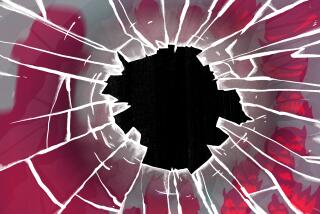A Downward Spiral Into Gripping Paranoia
- Share via
Nathaniel Lachenmeyer aims to draw lessons from his father’s 14-year battle with paranoid schizophrenia that apply to society as a whole. It was a tragic mistake, he confirms, to empty U.S. mental hospitals a generation ago without providing a safety net to keep ex-patients from becoming homeless. In an age when other forms of prejudice have ebbed, the mentally ill are still ridiculed and feared. People like his father are believed to be violent, Lachenmeyer says, when in fact most schizophrenics are a danger only to themselves: 10% commit suicide.
Still, this is a very personal memoir. In 1992, the 18-year-old Lachenmeyer broke ties with his father, Charles, a former sociology professor at Hunter College in New York, who by then was well into his downward spiral, bouncing between lesser jobs and hospital wards, believing himself to be the victim of a conspiracy by the CIA, the FBI and his ex-wife to control his thoughts. “I can’t live in your world, and you can’t live in mine,” Nathaniel wrote, dealing his father a blow whose severity he came to realize only after Charles died in a shabby rented room in Burlington, Vt., in 1995 at age 51.
Nathaniel discovered that this hovel was actually a step up for Charles, who had nearly frozen to death on the streets the previous winter. In his writings and in remarks to police, hospital staff and fellow transients, Charles had affirmed, over and over, his love for his lost son. Guilt-stricken, Nathaniel set out to trace his father’s wanderings, first in a documentary film in 1997 and now in this book.
Transients, we would think, leave few tracks. But Nathaniel was able to find out a surprising amount. People remembered Charles. Even lice-ridden and in rags, talking to his dead mother (whose Christian Science beliefs, Nathaniel says, introduced him to the notion that everything he experienced might be an illusion), he kept his proud bearing and his erudite vocabulary. He never stopped applying for college teaching posts, never stopped writing pamphlets to expose his tormentors.
If the “conspiracy” against him was imaginary, it caused Charles as much suffering as if it were real, Nathaniel points out. And it took just as much courage to fight. Charles believed himself to be living in a world like “The Matrix” or “The Truman Show,” in which every passerby might be an actor and every chance remark might be scripted to “jack him up,” trigger odd or violent behavior, and get him recommitted. To stay free in such a world took enormous self-control.
“Whatever I accomplish in my life,” Nathaniel says, “will never equal what my father accomplished as a mentally ill transient. Most of us are so used to defining ourselves and our self-worth in relation to our possessions and the perceptions of others that we would not have the necessary strength to insist that we still are who we once were if we found ourselves stripped of everything and everyone in our lives.”
Unfortunately, his disorder kept Charles, a gifted scholar who had once studied paranoid schizophrenia as if “preparing to do battle with a foe he expected to meet in the future,” from recognizing that he was insane. He viewed hospitals and medication as part of the conspiracy. When a legal guardian withheld Charles’ disability checks to force him to seek treatment, he preferred to freeze.
Can such self-destructive behavior have dignity and meaning? It did in his father’s case, Nathaniel asserts. Charles’ uniqueness shines through the pop-novel banality of his delusions. True, there are public-policy implications in “The Outsider,” an appeal for us to be kinder to the next smelly street-corner mutterer we see. But it all begins with this one man, painstakingly brought back to life.
More to Read
Sign up for our Book Club newsletter
Get the latest news, events and more from the Los Angeles Times Book Club, and help us get L.A. reading and talking.
You may occasionally receive promotional content from the Los Angeles Times.









